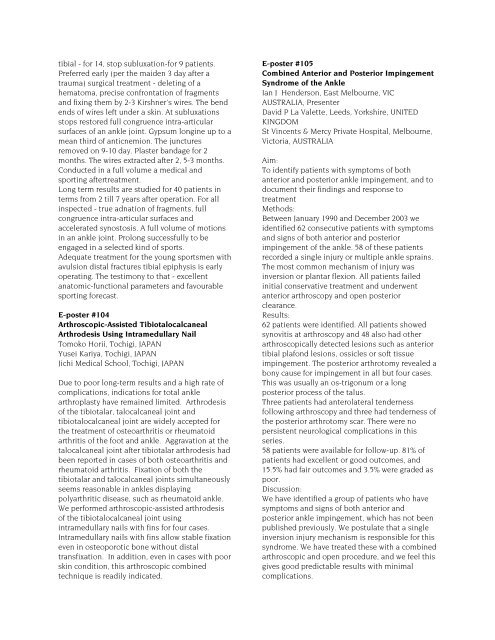POSTER ABSTRACTS - ISAKOS
POSTER ABSTRACTS - ISAKOS
POSTER ABSTRACTS - ISAKOS
Create successful ePaper yourself
Turn your PDF publications into a flip-book with our unique Google optimized e-Paper software.
tibial - for 14, stop subluxation-for 9 patients.<br />
Preferred early (per the maiden 3 day after a<br />
trauma) surgical treatment - deleting of a<br />
hematoma, precise confrontation of fragments<br />
and fixing them by 2-3 Kirshner's wires. The bend<br />
ends of wires left under a skin. At subluxations<br />
stops restored full congruence intra-articular<br />
surfaces of an ankle joint. Gypsum longine up to a<br />
mean third of anticnemion. The junctures<br />
removed on 9-10 day. Plaster bandage for 2<br />
months. The wires extracted after 2, 5-3 months.<br />
Conducted in a full volume a medical and<br />
sporting aftertreatment.<br />
Long term results are studied for 40 patients in<br />
terms from 2 till 7 years after operation. For all<br />
inspected - true adnation of fragments, full<br />
congruence intra-articular surfaces and<br />
accelerated synostosis. A full volume of motions<br />
in an ankle joint. Prolong successfully to be<br />
engaged in a selected kind of sports.<br />
Adequate treatment for the young sportsmen with<br />
avulsion distal fractures tibial epiphysis is early<br />
operating. The testimony to that - excellent<br />
anatomic-functional parameters and favourable<br />
sporting forecast.<br />
E-poster #104<br />
Arthroscopic-Assisted Tibiotalocalcaneal<br />
Arthrodesis Using Intramedullary Nail<br />
Tomoko Horii, Tochigi, JAPAN<br />
Yusei Kariya, Tochigi, JAPAN<br />
Jichi Medical School, Tochigi, JAPAN<br />
Due to poor long-term results and a high rate of<br />
complications, indications for total ankle<br />
arthroplasty have remained limited. Arthrodesis<br />
of the tibiotalar, talocalcaneal joint and<br />
tibiotalocalcaneal joint are widely accepted for<br />
the treatment of osteoarthritis or rheumatoid<br />
arthritis of the foot and ankle. Aggravation at the<br />
talocalcaneal joint after tibiotalar arthrodesis had<br />
been reported in cases of both osteoarthritis and<br />
rheumatoid arthritis. Fixation of both the<br />
tibiotalar and talocalcaneal joints simultaneously<br />
seems reasonable in ankles displaying<br />
polyarthritic disease, such as rheumatoid ankle.<br />
We performed arthroscopic-assisted arthrodesis<br />
of the tibiotalocalcaneal joint using<br />
intramedullary nails with fins for four cases.<br />
Intramedullary nails with fins allow stable fixation<br />
even in osteoporotic bone without distal<br />
transfixation. In addition, even in cases with poor<br />
skin condition, this arthroscopic combined<br />
technique is readily indicated.<br />
E-poster #105<br />
Combined Anterior and Posterior Impingement<br />
Syndrome of the Ankle<br />
Ian J Henderson, East Melbourne, VIC<br />
AUSTRALIA, Presenter<br />
David P La Valette, Leeds, Yorkshire, UNITED<br />
KINGDOM<br />
St Vincents & Mercy Private Hospital, Melbourne,<br />
Victoria, AUSTRALIA<br />
Aim:<br />
To identify patients with symptoms of both<br />
anterior and posterior ankle impingement, and to<br />
document their findings and response to<br />
treatment<br />
Methods:<br />
Between January 1990 and December 2003 we<br />
identified 62 consecutive patients with symptoms<br />
and signs of both anterior and posterior<br />
impingement of the ankle. 58 of these patients<br />
recorded a single injury or multiple ankle sprains.<br />
The most common mechanism of injury was<br />
inversion or plantar flexion. All patients failed<br />
initial conservative treatment and underwent<br />
anterior arthroscopy and open posterior<br />
clearance.<br />
Results:<br />
62 patients were identified. All patients showed<br />
synovitis at arthroscopy and 48 also had other<br />
arthroscopically detected lesions such as anterior<br />
tibial plafond lesions, ossicles or soft tissue<br />
impingement. The posterior arthrotomy revealed a<br />
bony cause for impingement in all but four cases.<br />
This was usually an os-trigonum or a long<br />
posterior process of the talus.<br />
Three patients had anterolateral tenderness<br />
following arthroscopy and three had tenderness of<br />
the posterior arthrotomy scar. There were no<br />
persistent neurological complications in this<br />
series.<br />
58 patients were available for follow-up. 81% of<br />
patients had excellent or good outcomes, and<br />
15.5% had fair outcomes and 3.5% were graded as<br />
poor.<br />
Discussion:<br />
We have identified a group of patients who have<br />
symptoms and signs of both anterior and<br />
posterior ankle impingement, which has not been<br />
published previously. We postulate that a single<br />
inversion injury mechanism is responsible for this<br />
syndrome. We have treated these with a combined<br />
arthroscopic and open procedure, and we feel this<br />
gives good predictable results with minimal<br />
complications.
















